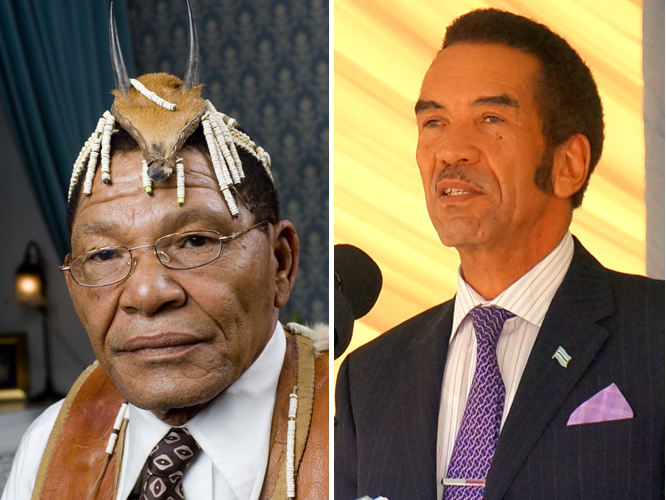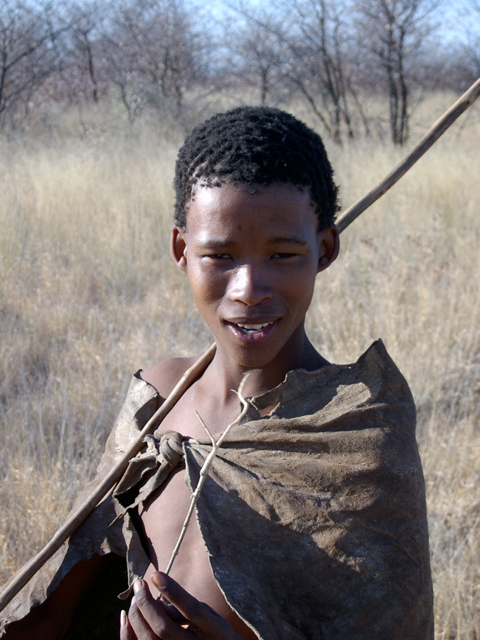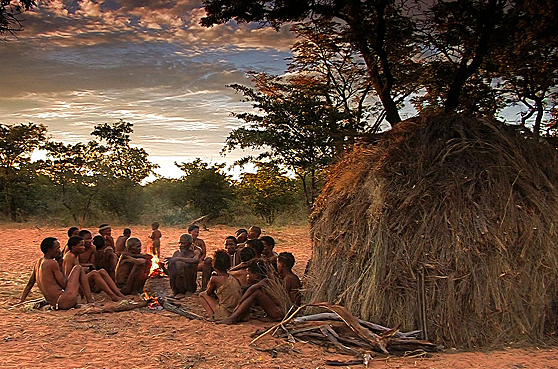One of the most fascinating recent news stories from Africa has been the remarkable reversal by the Botswana government, which has stopped persecuting the San and started promoting tourism for them instead.

When the news of this change surfaced a couple months ago, it was clear that many of the San people themselves were dismayed by what had happened. The change in government policy had apparently been reached by Roy Sesana, a long-time leader of the G/wi and the G//ana people, and Ian Khama, the President of Botswana. The San had been forcibly expelled from their homes in the Central Kalahari Game Reserve (CKGR) decades ago, and Sesana has led the struggle for regaining their rights. As part of the deal, however, Sesana had accepted a position with the government. But had he betrayed them? Had he sold out in order to secure a job for himself? What was to be expected of the San in their new roles as objects of tourism?
News stories over the intervening weeks have begun to shed some light on the questions that observers were asking in mid-February. A report published in early March pointed out that the anger against Sesana has not abated. Since he has taken a job with the government, many San are questioning how he could still truly represent them as a leader of their efforts to regain their rights to their lands in the CKGR.
Jumanda Gakelebone, who used to act as spokesperson for Sesana, has clearly broken with his former mentor over the issue. He and other San people were planning to meet to decide if Sesana should continue as their leader. Many San have told Gakelebone that when Sesana took the position in the government, offered to him by President Khama, he ceased to represent them.

The news report indicated that the San have prepared a list of demands occasioned by the controversy. First, they demand that the government must explain to them why it has suddenly decided to restore services such as community water supplies that it had terminated years before.
Secondly, the San want to draft a written agreement with government agents that the government will then sign. They feel that such an agreement will be a legal document that the government will not be able to back out of later. It is not clear yet if Gakelebone has directly confronted Sesana, or if the San of the CKGR have met to declare a new set of leaders.
A more recent news report describes the reactions of the San to plans by the government to develop photographic tourism in the CKGR—to make the G/wi and the G//ana people living there into objects for the tourists’ cameras. As with everything related to the San people, the government of Botswana discusses ideas and comes to decisions without consulting the people involved.

The reporter, Mpho Keleboge, quoted Bashi Thite, Councilor of Ghanzi Township East, just to the west of the CKGR, who complained that he, like everyone else, is aware of stories in the media but despite being on the local council has not had access to any real information. While the people appreciate the idea of having water services restored to them, they are suspicious of the plans of the Minister of Wildlife and Tourism, Tshekedi Khama (brother of the president), to promote photographic tourism.
Mr. Thite is not only miffed that he and others have not been consulted, he doubts that photographic tourism is a good fit for the San people. “We think Cultural tourism is better than Photographic because we have talents and we can showcase our culture to tourists,’’ he said. In essence, the San feel they would do better as tour guides and in other similar fields than simply posing as the subjects of tourists’ cameras.
Thite offers several positive suggestions for the government to consider. He argues that it should train them as tour guides. Photo tourism is not likely to succeed since there are few animals that tourists would want to take pictures of, except for some in the northern part of the CKGR.
He further suggests that the government should consider setting up a Cultural Village, where tourists could come and visit with the San people and be exposed to their poetry, dance, and music—where they could learn about the daily lives of the San and their cultures. Taking photos is clearly only a part of this broader conception of cultural tourism. The reporter quoted Mr. Gakelebone as saying more or less the same things—he opposes tourism that focuses on photography of the people only, and he supports the San providing cultural experiences for tourists.

Another San society, the Ju/’hoansi, have already begun working on a similar venture. According to a news report a month ago, the Living Museum of the Ju/’hoansi San has already been established near Tsumkwe, in northern Namibia. It has its own website, which indicates that it operates very similarly to the cultural village that Mr. Thite has proposed.
Cultural tourism has been spreading to other peaceful societies outside of southern Africa as well. A news report a couple weeks ago featured the influx of tourists to a Batek community in Malaysia, and a story six months earlier described how the Batek in another village were being trained as guides for tourists.
The tag “Tourists” in this website provides links to many reports about the creative ways people in minority societies around the world are adapting to, coping with, and in some cases benefiting from tourism. We can only hope that the government of Botswana will become familiar with the many possible ways of helping its minority citizens to protect themselves and to achieve their visions of their own futures.